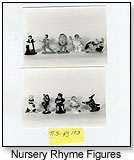
January 11, 2026


 Margaret Cloninger was an actress, and in 1935 had appeared on Broadway in ''L'Aiglon,'' and then remained with the company through their winter tour. However, according to Anna (Mrs. Hugh F.) Cloninger, ''Because of hard times in the theatre, she took up sculpting and became outstanding in the art. The girls (Cloninger and her girlhood friend, the sculptress Olive Kooken) roomed together. Most of their work was done by Epplesheimer and Company – the company made molds for Hershey bars among other things – but much of their casting was with this company, and Margaret Ruth married the vice-president and general manager, John D. Warren, whose father was owner and president.'' John Warren subsequently founded the Warren Lines soldier company.
Margaret Cloninger was an actress, and in 1935 had appeared on Broadway in ''L'Aiglon,'' and then remained with the company through their winter tour. However, according to Anna (Mrs. Hugh F.) Cloninger, ''Because of hard times in the theatre, she took up sculpting and became outstanding in the art. The girls (Cloninger and her girlhood friend, the sculptress Olive Kooken) roomed together. Most of their work was done by Epplesheimer and Company – the company made molds for Hershey bars among other things – but much of their casting was with this company, and Margaret Ruth married the vice-president and general manager, John D. Warren, whose father was owner and president.'' John Warren subsequently founded the Warren Lines soldier company. According to Mildred Orr Hirth, ''I believe Margaret selected a subject to do, Olive helped her get started, corrected the figure when it was about half finished, and went over it at the end. She was trying to help her financially, but I think most of the work was Olive's.'' (Anna Cloninger remembers her relative also sculpted ''zoo animals'' in addition to her ''figures of nursery rhyme characters, soldiers and horses.'')
According to Mildred Orr Hirth, ''I believe Margaret selected a subject to do, Olive helped her get started, corrected the figure when it was about half finished, and went over it at the end. She was trying to help her financially, but I think most of the work was Olive's.'' (Anna Cloninger remembers her relative also sculpted ''zoo animals'' in addition to her ''figures of nursery rhyme characters, soldiers and horses.'') At least two of the Tommy Toy soldiers would seem definitely to have been done by Kooken, since they turned up again as Barclay podfoot figures – the wounded soldier holding his helmet, and the nurse with the towel over her arm. Kooken's work was generally distinguished by a smooth, nearly wrinkle-free look, quite different from the more realistic figures produced by Frank Krupp, who preceded her at Barclay. Unless Sally Newman is correct and Kooken did begin work for Barclay in the late 1920s, the sculptress' first work for Barclay appears to have been its civilian train figures, and then, around 1940, its cast-helmet soldiers.
At least two of the Tommy Toy soldiers would seem definitely to have been done by Kooken, since they turned up again as Barclay podfoot figures – the wounded soldier holding his helmet, and the nurse with the towel over her arm. Kooken's work was generally distinguished by a smooth, nearly wrinkle-free look, quite different from the more realistic figures produced by Frank Krupp, who preceded her at Barclay. Unless Sally Newman is correct and Kooken did begin work for Barclay in the late 1920s, the sculptress' first work for Barclay appears to have been its civilian train figures, and then, around 1940, its cast-helmet soldiers.
Copyright © 2026 TDmonthly®, a division of TOYDIRECTORY.com®,
Inc.